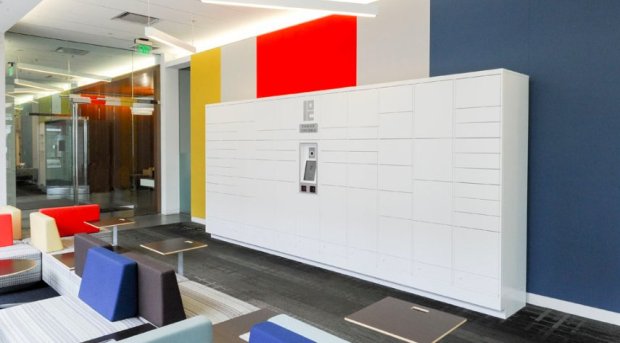Package Lockers Gain Ground At Apartments

Last mile? How about last few feet?
The rise of the locker is a … lock. Amazon, of course, with heft and scale, has entered the market in a big way: Late last year the eCommerce giant began signing contracts with apartment operators to install Amazon Lockers in those locations. The initial splash is a sizable one, with the contracts signed by the company spanning 850,000 units nationwide, with presence at apartment operators including AvalonBay Communities and Equity Residential, among others.
In a bit of a different business model, Walmart said earlier this month that it is rolling out hundreds more of its Pickup Towers to its U.S. locations throughout the year. The lockers, of course, are located in-store and offer a place for customers to pick up their online orders.
The premise is a simple one, where packages come to a designated location — the locker — and the resident is notified via technology of a delivery. A code is used to gain access to that locker and retrieve the package.
The problem a streamlined retrieval process (aided by technology) seeks to solve is a glaring and growing one.
Simply put, stuff accumulates where people live — especially in dorms and apartment complexes. Packages line hallways, lobbies, mailrooms and overwhelm staff.
We all know the lure of buying things online and having them delivered, from clothes to electronics to meals. So, the challenges remain: How to alleviate the congestion? How to shift the workload from apartment staff sorting, stacking and — one would assume — somewhat frantically trying to find space to store the deluge of daily deliveries?
A package makes its journey across transportation modes, time zones, even country borders, with a final stop at the apartment or university dorm. And there it sits — in a doorway or mailroom or lost in some shuffle, with delayed pickups. Weather plays a factor in retrieval, and so do hectic schedules.
As noted by Mann Report Management, that buzz of activity means the average apartment complex receives 20,000 packages annually. It’s no surprise, then, that some startups would seek to make inroads where Amazon is treading as well and where Walmart is bringing the delivery off-premise, which, in turn, also diverts packages from cluttering the homefront.
Against that backdrop, Package Concierge, based in Massachusetts, is leveraging mobile conduits to help manage the ever-increasing tide of packages. The company’s digital locker systems allow for round-the-clock package management, featuring steel lockers and aided by a kiosk system. In the starkest terms, managers track the cycle of deliveries and retrieval, with error-free confirmation on both ends.
The company has said carriers such as FedEx and UPS and others can deliver packages to the system. When delivering items to the locker, the end user gets a text or email notification. And to pick up that package, the recipient enters a PIN to open the locker and retrieve the package.
In an interview with PYMNTS, Georgianna Oliver, founder of the firm, said the overall goal is to “alleviate the risk of theft, clutter or unnecessary or burdensome processes for handling packages.”
Apartment communities and colleges are proving to be early adopters of the package concierge system.
“A strongly emerging vertical is retail stores,” said Oliver. “We are beginning [to] add lockers for BOPUS (Buy Online Pick Up In-Store) with customers across the country.”
In reference to those steps, Oliver stated that package delivery systems streamline steps in the process, where, without lockers in place, inefficiencies grow. Delivery carriers would either have to visit every apartment on a case-by-case basis or leave packages with management. Thus, at times, lost packages and confusion muddy the process. The actual package handling — done traditionally — involves six manual steps. The company’s locker system, by way of contrast, said Oliver, takes eight seconds. As a result, carriers are able to deliver several items at once.
As for the notifications themselves, she stated alerts are “only provided to the consumer, but at the consumer’s request could easily be provided to the company or a third party.”
Asked by PYMNTS about returns, the executive said, “a consumer can return a package easily through the [company’s] system. Once their label is printed, the carrier is notified. Then, when the delivery carrier arrives, they are alerted that there are return packages available” for pickup.
